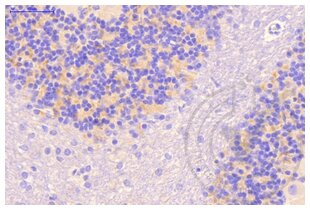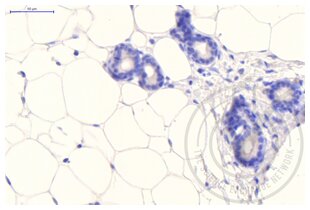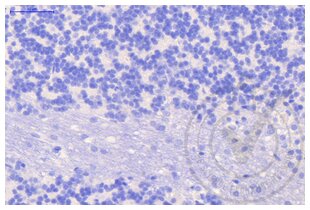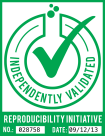Clathrin antibody (AA 4-171)
-
- Target See all Clathrin products
- Clathrin
-
Binding Specificity
- AA 4-171
- Reactivity
- Human, Mouse, Rat, Chicken, Dog
-
Host
- Mouse
-
Clonality
- Monoclonal
-
Conjugate
- This Clathrin antibody is un-conjugated
-
Application
- Immunohistochemistry (IHC), Western Blotting (WB), Immunofluorescence (IF), Immunoprecipitation (IP), BioImaging (BI)
- Cross-Reactivity
- Human, Chicken, Dog (Canine), Mouse (Murine)
- Characteristics
-
1. Since applications vary, each investigator should titrate the reagent to obtain optimal results.
2. Please refer to us for technical protocols.
3. Caution: Sodium azide yields highly toxic hydrazoic acid under acidic conditions. Dilute azide compounds in running water before discarding to avoid accumulation of potentially explosive deposits in plumbing.
4. Source of all serum proteins is from USDA inspected abattoirs located in the United States. - Purification
- The monoclonal antibody was purified from tissue culture supernatant or ascites by affinity chromatography.
- Immunogen
- Rat Clathrin Heavy Chain aa. 4-171
- Clone
- 23-Clathrin Heavy Chain
- Isotype
- IgG1
-
-
- Application Notes
-
Immunofluorescent Staining and Bioimaging Methanol Procedure for a 96 well plate: Remove media from wells. Add 100 µl/well fresh 3.7% Formaldehyde in PBS. Incubate for 10 minutes at room temperature (RT). Flick out and add 100 µl/well 90% methanol. Incubate for 5 minutes at RT. Flick out and wash twice with PBS. Flick out PBS and add 100 µl/well blocking buffer (3% FBS in PBS). Incubate for 30 minutes at RT. Flick out and add diluted antibody (diluted in blocking buffer). Incubate for 1 hour at RT. Wash three times with PBS. Flick out PBS and add second step reagent. Incubate for 1 hour at RT. Wash three times with PBS.
Triton-X 100 Procedure for a 96 well plate: Remove media from wells. Add 100 µl/well fresh 3.7% Formaldehyde in PBS. Incubate for 10 minutes at room temperature (RT). Flick out and add 100 µl/well 0.1% Triton-X 100. Incubate for 5 minutes at RT. Flick out and wash twice with PBS. Flick out PBS and add 100 µl/well blocking buffer (3% FBS in PBS). Incubate for 30 minutes at RT. Flick out and add diluted antibody (diluted in blocking buffer). Incubate for 1 hour at RT. Flick out and wash three times with PBS. Flick out and add second step reagent. Incubate for 1 hour at RT. Flick out and wash three times with PBS. - Comment
-
Related Products: ABIN968535
- Restrictions
- For Research Use only
-
- by
- Reveal Biosciences
- No.
- #028758
- Date
- 09/12/2013
- Antigen
- Lot Number
- 14494
- Method validated
- Immunohistochemistry
- Positive Control
- Brain
- Negative Control
- White adipose tissue
- Notes
- Signal was detected in positive control sample and not in negative control sample.
- Primary Antibody
- Antibody: Clathrin (AA 4-171,Heavy Chain)
- Catalog number: ABIN968006
- Lot number: 14494
- Secondary Antibody
- Antibody: Rabbit anti-mouse IgG HRP
- Lot number: YYDW56G
- Full Protocol
- Immunohistochemistry was performed on a Leica Bond automated immunostainer.
- Sections were deparaffinized with Novocastra Bond Dewax Solution and rehydrated into Leica Bond
- Wash Buffer.
- Sections were heated to 98°C for 20 minutes in Tris buffer pH 9.0 (ER2; Leica) for antigen retrieval.
- Sections were blocked in 3% normal goat serum plus 0.1 % Triton-X100 for 10 min at room
- temperature.
- Sections were washed x 3 in Leica Bond Wash Buffer.
- Sections were incubated with primary antibody diluted 1:100 in Universal Antibody Dilution Buffer
- (Electron Microscopy Sciences, 25885-05) for 60 min at room temperature.
- Sections were washed x 3 in Leica Bond Wash Buffer.
- Sections were incubated with secondary antibody diluted 1:100 in Universal Antibody Dilution Buffer
- (Electron Microscopy Sciences, 25885-05) for 60 min at room temperature..
- Sections were washed x 4 in Leica Bond Wash Buffer.
- Sections were washed x 1 in Distilled Water. Sections were incubated with Peroxide Block (Leica) for 10 min to block endogenous peroxidase.
- Sections were washed x 4 in Leica Bond Wash Buffer.
- Sections were incubated with DAB chromogenic substrate (Leica) for 10 min at RT.
- Sections were washed x 3 in Distilled Water.
- Sections were counterstained with hematoxylin (Leica) for 2 min.
- Sections were washed x 1 in Distilled Water.
- Sections were washed x 1 in Leica Bond Wash Buffer.
- Sections were washed x 1 in Distilled Water.
- Sections were dehydrated, mounted and photographed under a light microscope.
- Experimental Notes
- - Nothing to note.
Validation #028758 (Immunohistochemistry)![Successfully validated 'Independent Validation' Badge]()
![Successfully validated 'Independent Validation' Badge]() Validation ImagesFull Methods
Validation ImagesFull Methods -
- Format
- Liquid
- Concentration
- 0.25 mg/ml
- Buffer
- Aqueous buffered solution containing BSA, glycerol, and ≤0.09 % sodium azide.
- Preservative
- Sodium azide
- Precaution of Use
- This product contains Sodium azide: a POISONOUS AND HAZARDOUS SUBSTANCE which should be handled by trained staff only.
- Storage
- -20 °C
- Storage Comment
- Store undiluted at -20° C.
-
-
: "Interaction of FK506-binding protein 13 with brefeldin A-inhibited guanine nucleotide-exchange protein 1 (BIG1): effects of FK506." in: Proceedings of the National Academy of Sciences of the United States of America, Vol. 100, Issue 5, pp. 2322-7, (2003) (PubMed).
: "Clint: a novel clathrin-binding ENTH-domain protein at the Golgi." in: Molecular biology of the cell, Vol. 13, Issue 11, pp. 4060-73, (2002) (PubMed).
: "Growth hormone receptor ubiquitination coincides with recruitment to clathrin-coated membrane domains." in: The Journal of biological chemistry, Vol. 276, Issue 6, pp. 3778-84, (2001) (PubMed).
: "Identification of clathrin and clathrin adaptors on tubulovesicles of gastric acid secretory (oxyntic) cells." in: The American journal of physiology, Vol. 274, Issue 4 Pt 1, pp. C1017-29, (1998) (PubMed).
: "Regulation of clathrin assembly and trimerization defined using recombinant triskelion hubs." in: Cell, Vol. 83, Issue 2, pp. 257-67, (1995) (PubMed).
-
: "Interaction of FK506-binding protein 13 with brefeldin A-inhibited guanine nucleotide-exchange protein 1 (BIG1): effects of FK506." in: Proceedings of the National Academy of Sciences of the United States of America, Vol. 100, Issue 5, pp. 2322-7, (2003) (PubMed).
-
- Target
- Clathrin
- Abstract
- Clathrin Products
- Synonyms
- CG9012 antibody, CHC antibody, CLH antibody, Cla antibody, D-Chc antibody, Dmel\\CG9012 antibody, chc antibody, dCHC antibody, l(1)13Fb antibody, l(1)G0438 antibody, l(1)VI antibody, CG6948 antibody, CLC antibody, Dmel\\CG6948 antibody, clc antibody, Clathrin heavy chain antibody, Clathrin light chain antibody, Chc antibody, Clc antibody
- Background
- Clathrin is the major protein component in the coat formed around pits and vesicles involved in receptor-mediated endocytosis. Clathrin forms a non-covalently bound triskelion structure composed of three heavy chains (192 kDa each) and three light chains (23-25 kDa each). Each leg of the triskelion structure contains one heavy and one light chain. The three heavy chains forming the triskelion structure are attached at their respective proximal ends like spokes on a wheel. Clathrin heavy chain is composed of a terminal globular domain, a distal segment containing several areas sensitive to enzymatic cleavage, and a proximal segment which contains a light chain binding site. The proximal and distal domains are connected by a joint segment at which there is a sharp bend in the heavy chains of fully-assembled triskelia. Although the calculated molecular weight is 192 kDa, clathrin heavy chain migrates at approximately 180 kDa.
- Molecular Weight
- 180 kDa
-





 (5 references)
(5 references) (1 validation)
(1 validation)



